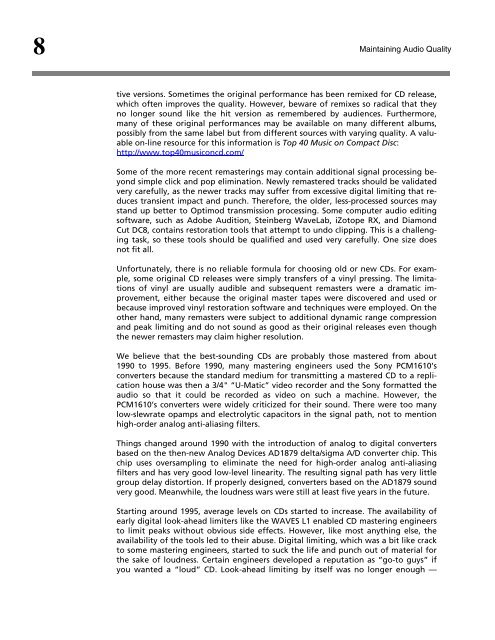Maintaining Audio Quality in the Broadcast Facility 2011 - Orban
Maintaining Audio Quality in the Broadcast Facility 2011 - Orban
Maintaining Audio Quality in the Broadcast Facility 2011 - Orban
Create successful ePaper yourself
Turn your PDF publications into a flip-book with our unique Google optimized e-Paper software.
8<br />
<strong>Ma<strong>in</strong>ta<strong>in</strong><strong>in</strong>g</strong> <strong>Audio</strong> <strong>Quality</strong><br />
tive versions. Sometimes <strong>the</strong> orig<strong>in</strong>al performance has been remixed for CD release,<br />
which often improves <strong>the</strong> quality. However, beware of remixes so radical that <strong>the</strong>y<br />
no longer sound like <strong>the</strong> hit version as remembered by audiences. Fur<strong>the</strong>rmore,<br />
many of <strong>the</strong>se orig<strong>in</strong>al performances may be available on many different albums,<br />
possibly from <strong>the</strong> same label but from different sources with vary<strong>in</strong>g quality. A valuable<br />
on-l<strong>in</strong>e resource for this <strong>in</strong>formation is Top 40 Music on Compact Disc:<br />
http://www.top40musiconcd.com/<br />
Some of <strong>the</strong> more recent remaster<strong>in</strong>gs may conta<strong>in</strong> additional signal process<strong>in</strong>g beyond<br />
simple click and pop elim<strong>in</strong>ation. Newly remastered tracks should be validated<br />
very carefully, as <strong>the</strong> newer tracks may suffer from excessive digital limit<strong>in</strong>g that reduces<br />
transient impact and punch. Therefore, <strong>the</strong> older, less-processed sources may<br />
stand up better to Optimod transmission process<strong>in</strong>g. Some computer audio edit<strong>in</strong>g<br />
software, such as Adobe Audition, Ste<strong>in</strong>berg WaveLab, iZotope RX, and Diamond<br />
Cut DC8, conta<strong>in</strong>s restoration tools that attempt to undo clipp<strong>in</strong>g. This is a challeng<strong>in</strong>g<br />
task, so <strong>the</strong>se tools should be qualified and used very carefully. One size does<br />
not fit all.<br />
Unfortunately, <strong>the</strong>re is no reliable formula for choos<strong>in</strong>g old or new CDs. For example,<br />
some orig<strong>in</strong>al CD releases were simply transfers of a v<strong>in</strong>yl press<strong>in</strong>g. The limitations<br />
of v<strong>in</strong>yl are usually audible and subsequent remasters were a dramatic improvement,<br />
ei<strong>the</strong>r because <strong>the</strong> orig<strong>in</strong>al master tapes were discovered and used or<br />
because improved v<strong>in</strong>yl restoration software and techniques were employed. On <strong>the</strong><br />
o<strong>the</strong>r hand, many remasters were subject to additional dynamic range compression<br />
and peak limit<strong>in</strong>g and do not sound as good as <strong>the</strong>ir orig<strong>in</strong>al releases even though<br />
<strong>the</strong> newer remasters may claim higher resolution.<br />
We believe that <strong>the</strong> best-sound<strong>in</strong>g CDs are probably those mastered from about<br />
1990 to 1995. Before 1990, many master<strong>in</strong>g eng<strong>in</strong>eers used <strong>the</strong> Sony PCM1610’s<br />
converters because <strong>the</strong> standard medium for transmitt<strong>in</strong>g a mastered CD to a replication<br />
house was <strong>the</strong>n a 3/4" “U-Matic” video recorder and <strong>the</strong> Sony formatted <strong>the</strong><br />
audio so that it could be recorded as video on such a mach<strong>in</strong>e. However, <strong>the</strong><br />
PCM1610’s converters were widely criticized for <strong>the</strong>ir sound. There were too many<br />
low-slewrate opamps and electrolytic capacitors <strong>in</strong> <strong>the</strong> signal path, not to mention<br />
high-order analog anti-alias<strong>in</strong>g filters.<br />
Th<strong>in</strong>gs changed around 1990 with <strong>the</strong> <strong>in</strong>troduction of analog to digital converters<br />
based on <strong>the</strong> <strong>the</strong>n-new Analog Devices AD1879 delta/sigma A/D converter chip. This<br />
chip uses oversampl<strong>in</strong>g to elim<strong>in</strong>ate <strong>the</strong> need for high-order analog anti-alias<strong>in</strong>g<br />
filters and has very good low-level l<strong>in</strong>earity. The result<strong>in</strong>g signal path has very little<br />
group delay distortion. If properly designed, converters based on <strong>the</strong> AD1879 sound<br />
very good. Meanwhile, <strong>the</strong> loudness wars were still at least five years <strong>in</strong> <strong>the</strong> future.<br />
Start<strong>in</strong>g around 1995, average levels on CDs started to <strong>in</strong>crease. The availability of<br />
early digital look-ahead limiters like <strong>the</strong> WAVES L1 enabled CD master<strong>in</strong>g eng<strong>in</strong>eers<br />
to limit peaks without obvious side effects. However, like most anyth<strong>in</strong>g else, <strong>the</strong><br />
availability of <strong>the</strong> tools led to <strong>the</strong>ir abuse. Digital limit<strong>in</strong>g, which was a bit like crack<br />
to some master<strong>in</strong>g eng<strong>in</strong>eers, started to suck <strong>the</strong> life and punch out of material for<br />
<strong>the</strong> sake of loudness. Certa<strong>in</strong> eng<strong>in</strong>eers developed a reputation as “go-to guys” if<br />
you wanted a “loud” CD. Look-ahead limit<strong>in</strong>g by itself was no longer enough —



![[PDF] Using the ITU BS.1770-2 and CBS Loudness Meters ... - Orban](https://img.yumpu.com/50629372/1/190x245/pdf-using-the-itu-bs1770-2-and-cbs-loudness-meters-orban.jpg?quality=85)






![[PDF] Optimod-FM Feature Comparison - Orban](https://img.yumpu.com/41741615/1/190x245/pdf-optimod-fm-feature-comparison-orban.jpg?quality=85)






